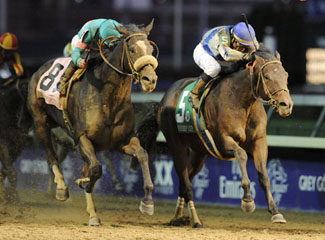21 November 2010
Becoming a Centaur
In competitive, individualistic America this headline from Chakra might surprise more than a few people: "Buddhist Monk Horse Rider Wins Gold at Asian Games" It shouldn't. Buddhism, as I understand it, is about becoming one with the universe. In many ways, so is riding.
The linkages to dressage riding and strains of Buddhism are strong. My favorite American and European dressage authorities all stress the connection between horse and rider, ribbons and trophies are rarely the goal. Although this is the first time I've read about Buddhism in connection with jumping, I've found similar expressions of the need for connection in works by some of the best authorities on jumping. In fact, I think I first read about show results being at best secondary to horse-rider team performance in Riding and Jumping by William Steinkraus, a book I need to reread.
A happy effect of globalization is that more than a handful of American riders and trainers now use meditation and martial arts training to advance their riding skills. Here, for example, is a line from American dressage master Paul Belasik's Exploring Dressage Technique: "All the best riders have tried to exalt the horse, to ride it carefully, as a reverent thank you for the gift of travel--real travel towards enlightenment."
One such brief moment of enlightenment was caught on tape appears in the 1963 Disney movie The Miracle of the White Stallions. Watch for the pirouettes in the performance before Patton. Alois Podhajsky, doubling for actor Robert Taylor who portrayed him in the movie, said those pirouettes were what every horseman hopes to experience a few times, a moment of effortless oneness, a glimpse of nirvana.
I've had a few moments like that just jogging down a trail or riding twenty meter circles. Suddenly there was no horse, no rider; there was just inner peace. My horse had to have felt it too or the moments would never have happened.
I've long held that learning to ride a horse is about introspection, calmness, empathy, and erasure of the self. In the article, Buddhist monk Kenki Sato said his "special life path" was to "become one" with his horse. I suspect my fascination with the partnership started when, as a small child, I saw depictions of centaurs. Whatever our inspiration, for some of us, working with horses is a never-ending path, a pursuit of happiness and self-discovery, perhaps even enlightenment and bliss. It's a good path.
09 November 2010
Fabulous Losses
Horse racing isn't all about horses; it's all about the finish line. In some cases, however, the finish line hardly tells the full story. Two losing efforts stand out in my mind as examples. In the 1976 Jockey Club Gold Cup, Seattle Slew showed me he was indeed one of the best race horses of all time and in last weekend's Breeders' Cup Classic, Zenyatta crossed the finish line a few inches short and left me wondering how much speed and stamina she actually had.
Both Slew and Zenyatta were clearly running faster than the winners when the finish line ended the race; they both simply ran out of race distance. However, these two races were vastly different.
In the 1978 race, Exceller's camp had used a legal tactic to bring down Slew; they entered a "rabbit," a horse with great early speed but not capable of going the mile and a half distance to quicken the pace and burn out competitive horses like Slew and Affirmed, the other Triple Crown Winner entered in the race. The plan worked. Hall of Fame distance horse Exceller won, but not by much.
Despite having gone most of the race in blistering fractions, Slew dug deep and battled back to the surprise of most knowledgeable watchers, me included. Passed by the great Exceller, Slew didn't fold. Switching his tail in exhaustion, Slew drew on what horse people call "heart," and dug in for a final drive that, like Zenyatta's, carried him in front of his rival just a few strides too late.
These two losses, however, were vastly different. While Slew was set up and responded with Spartan determination and effort, Zenyatta lost simply because of racing luck and her heart-stopping racing style. Running from behind is not an easy style. Statistically, racing from the front or near the front produces far more winning efforts.
Mike Smith nobly took responsibility for her loss, but what happened is intrinsic in the late run style. Here, unfortunately for Zenyatta and her fans, the field split into two groups, carrying her way too far back for a stretch run. Considering her utterly dismal first quarter and the circumstances that put her something like twenty lengths back, her second place finish was in itself astonishing. For me though, the major difference between these two losses was that it didn't look like Zenyatta was running all that hard.
This stretch photo shows Zenyatta wearing her usual, relaxed, floppy-eared expression as she was gaining on Blame. On the other hand, Blame was the one that had dug in. He was the one with the switching tail. He was the one with his ears pinned in determination. He was the one showing what horsemen call "grit." The mare was eating up ground, suggesting that Smith was not exaggerating when he said he a lot of horse left. This photo shows that. She looks like a horse doing her usual job of running down the front horse in the last few hundred yards. Nothing special.
Unfortunately, races are absolutes. Style counts for nothing--except maybe in the hearts of horsemen who like horses more than horse racing.
Here are links to both these races:
1978 Jockey Club Gold Cup
2010 Breeders' Cup Classic
Subscribe to:
Comments (Atom)

